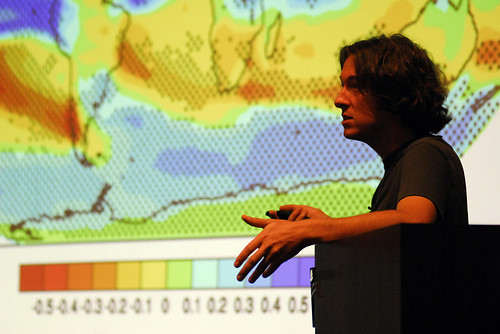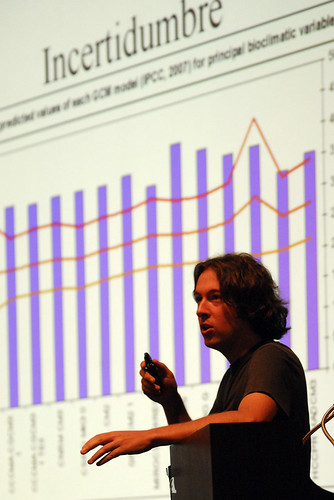 On Thursday morning, Andy Jarvis led the KSW 2009 special session on climate change and CIAT research.
On Thursday morning, Andy Jarvis led the KSW 2009 special session on climate change and CIAT research.He started by introducing the various global climate models and emission scenarios. They generally show a world that is warmer everywhere, in some places much warmer. It will also be wetter in most places, though some areas will be a bit drier.
Taking account of the different levels of uncertainty in each model and scenario, CIAT can use this data to project conditions in different research locations in 2020 and 2050.
Overall, he stated, global suitability for the top 50 crops increases. The question is which ones, and where.
 He described models used by CIAT and partners to 'map' the broad suitability of different crops in different regions, now and in 2020 and 2050.
He described models used by CIAT and partners to 'map' the broad suitability of different crops in different regions, now and in 2020 and 2050.These maps show many changes. Suitable conditions for some crops will increase; others will decrease. Some regions that currently grow, for example, maize or coffee, will no longer have conditions suited to these crops. Areas currently unsuitable, to cassava for instance, will become suitable. Production is likely to move to other, more suitable areas. Farmers will need to find substitute crops.
Some regions will be hard hit. In Southern Africa, conditions are likely to change so that maize will become unsuitable. Major agricultural - and even cultural - changes will be needed. The entire value chain of a product, he argued - from producer to consumer - will be affected, and will need to be transformed.
These models can also help in priority setting. The results of research, such as increasing a crop's suitability through improved heat or drought tolerance, can be included in the models to can help indicate the likely impacts of different CIAT research investments in different locations.
His conclusions for CIAT:
- There is no single panacea in breeding strategies for most CIAT crops;
- Regions face challenges at both ends of the spectrum – heat, drought, too wet;
- Increased work is needed on the socio-economic implications;
- Research needs to design now for 2020 climate conditions;
- We face a serious scientific gap in understanding crop substitution, current models assume that a maize farmer today will be a maize farmer tomorrow. In reality, many will need to select a different crop to what they have now.

No comments:
Post a Comment